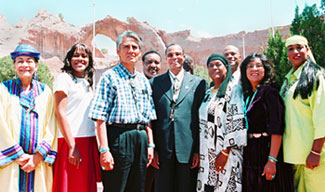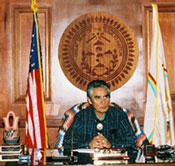10 things to know about the Navajo Nation
By Dora MuhammadManaging Editor | Last updated: Aug 1, 2006 - 11:32:00 AM
What's your opinion on this article?
- A meeting between mighty men of vision (FCN, 08-01-2006)
- Broaden your horizons (FCN, 08-01-2006)

Navajo Nation President Joe Shirley and the Honorable Minister Louis Farrakhan (c), with the Nation of Islam delegation, in front of the Window Rock stone formation, located in Window Rock, Ariz. Photos: Dora Muhammad
|
1. The Navajo Nation is the largest federally recognized Native American tribe in the United States, with an estimated 300,000 members. The 83-year-old nation is the only native Indigenous tribe to have signed a treaty with the U.S. government, implicitly establishing recognition of its sovereignty as a nation.
|
Power to the Indigenous people In 1994, the United States completed its first draft Declaration on the Rights of Indigenous Peoples: “Reaffirming also that indigenous peoples, in the exercise of their rights, should be free from discrimination of any kind, “Concerned that indigenous peoples have been deprived of their human rights and fundamental freedoms, resulting, inter alia, in their colonization and dispossession of their lands, territories and resources, thus preventing them from exercising, in particular, their right to development in accordance with their own needs and interests, “Recognizing the urgent need to respect and promote the inherent rights and characteristics of indigenous peoples, especially their rights to their lands, territories and resources, which derive from their political, economic and social structures and from their cultures, spiritual traditions, histories and philosophies, “Welcoming the fact that indigenous peoples are organizing themselves for political, economic, social and cultural enhancement and in order to bring an end to all forms of discrimination and oppression wherever they occur, “Convinced that control by indigenous peoples over developments affecting them and their lands, territories and resources will enable them to maintain and strengthen their institutions, cultures and traditions, and to promote their development in accordance with their aspirations and needs”… |
3. The tribal government of Navajoland consists of three branches: executive, legislative and judicial. The Navajo Nation Council has the authority to pass laws that govern the Navajo Nation, members of the Navajo Nation, and certain conduct of non-member Indians and non-Indians within the territorial boundaries of the Navajo Nation. An 88-member, popularly elected Council represents 110 local government subdivisions, or chapters, throughout Navajoland. Twelve standing committees carry out legislative work when the council is not in session.
4. Spanning 27,000 square miles across the states of Arizona, New Mexico and Utah, the Navajo land is not referred to as a reservation. Navajoland is comprised of the original treaty reservation, trust lands, allotted land and purchased land. The approximately 18 million acres of land, which is highly remote and isolated, is rich in oil, surface ground water, coal and natural gas.
5. While maintaining focus on retaining its traditional ways through initiatives like the Dine Fundamental Law, the Navajo Nation has also kept a keen eye on the future by installing a telecommunications infrastructure that links Navajo chapters and households through its fiber optic network.
6. The Four Corners—where the states of Arizona, Colorado, Utah and New Mexico converge—is one of the richest sources of this continent’s mineral wealth. As a result, the historic and contemporary relationship between the native tribes that live in this region and the oil and gas companies has been rife with tension and conflicts. From government negligence in holding corporations accountable to contracts to the reckless abandon of corporate natural resource exploration, accusations have been hurled of energy exploitation, resource corruption and land desecration.
7. Disputes over the First Americans claims to water rights are not unique to the Navajo, however, their battle included a lawsuit against the federal government for un-quantified Colorado River water rights. One of its tributaries, the San Juan River, is the center of a contentious yet unprecedented settlement between the Navajo and New Mexico. The water rights settlement provides for a 250-mile pipeline—of which the Navajo would control 36,000 acre-feet—that would bring water for use or lease in the Navajo communities in New Mexico. It also has $800 million water infrastructure projects attached to it.

President Joe Shirley
|
9. “We do not inherit the Earth from our ancestor, we borrow it from our children,” says a Native American proverb. The Navajo passed a Dine Natural Resources Protection Act in 2005, which prohibits uranium mining or processing within the Navajo Nation, as a result of the water and land contamination and a radioactive spill caused by uranium mining and processing on its lands.
10. The president of the Navajo Nation, Joe Shirley, has been reaching out for help and unity with Black and Indigenous communities, domestic and abroad, to assist in reversing the disintegrating infrastructure and neglect of Navajo communities. He has worked with the League of United Latin American Citizens, the oldest and largest Latino membership organization, in 2005 to fight against new uranium mines in territories that would affect both Latino and Native peoples. As recently as June this year, he hosted Indigenous leaders from Australia to discuss common issues, problems and solutions.
INSIDE STORIES AND REVIEWS
-
-
About Harriett ... and the Negro Hollywood Road Show
By Rabiah Muhammad, Guest Columnist » Full Story -
Skepticism greets Jay-Z, NFL talk of inspiring change
By Bryan 18X Crawford and Richard B. Muhammad The Final Call Newspaper @TheFinalCall » Full Story -
The painful problem of Black girls and suicide
By Charlene Muhammad -National Correspondent- » Full Story -
Exploitation of Innocence - Report: Perceptions, policies hurting Black girls
By Charlene Muhammad -National Correspondent- » Full Story -
Big Ballin: Big ideas fuel a father’s Big Baller Brand and brash business sense
By Bryan Crawford -Contributing Writer- » Full Story






 Click Here Stay Connected!
Click Here Stay Connected!








